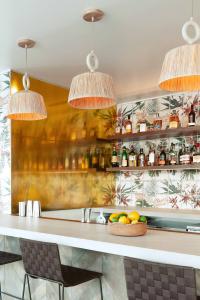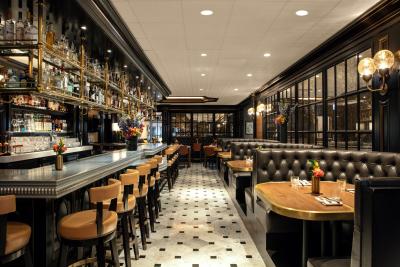As chef at The Parlour in the InterContinental New York Barclay, Ruben Ruggier offers an apt take on how making a hotel restaurant stand out can make it competitive with many buzzworthy standalone restaurants in town.
“The root word in ‘restaurant’ is ‘restore,’ and when you think about it, a hotel is a place you go to find restoration somewhere that doesn’t happen to be your own home,” Ruggier explains, noting The Parlour’s decor is inspired by the hotel’s 1920s origin while the food and beverage program reflect its history, city and culture. “The concept of a restaurant goes hand in hand with the philosophy of a hotel. When you visit The Parlour, you’ll find that we maintain a homey atmosphere that encompasses the elements of comfort and restoration—from the cozy chairs and fireplace to the dishes we offer our patrons.”
The Restaurant Evolution
“A well-conceptualized on-site dining experience provides a distinct competitive advantage to the hotel,” said Alfio Celia, vice president, food and beverage of Crescent Hotels & Resorts' Restaurant Group. “Not only does it enhance the overall value for guests, it contributes to the hotel's identity as a destination. [However], we also want to transform a hotel restaurant into a neighborhood gem and culinary destination.”
Andrea DeRosa, co-founder and principal of Las Vegas-based Avenue Interior Design, agrees that there has been a real evolution of the perception of a ‘hotel’ restaurant in the eyes of the consumer over the past decade. She points out her firm’s work to bring the Rouge Room at the Red Rocks Casino to life embodies that shift.
“It’s imperative the restaurant be a destination on its own accord, and unless it is intended to be woven into a lobby lounge, there needs to be a unique concept for the restaurant on property,” she said. “It is preferred to have the chef, restaurant group and menu concept engaged prior to the start of design to capitalize on those elements for the design narrative. It has to … have a well-conceived identity.”
DeRosa detailed that the team behind Rouge Room capitalized on Las Vegas’ climate advantage by converting the existing space into a day-and-night club venue offering the versatility of offering an indoor/outdoor experience. The concept for the property was also inspired by the bespoke supper clubs of Las Vegas’s past. Live performances some evenings, meanwhile, create a new experience for return guests.

“Space planning, capacity, and the existing kitchen layout and function all shape the program for a restaurant renovation or repositioning,” she continued. “Access directly from the exterior, without having to enter through a lobby, is generally preferred to capture the local patrons. With the food program, seasonal menus, guest chef collaborations and events garner a lot of attention, especially for local patrons.”
In a similar fashion, designers and management for Videre Restaurant & Bar at the Kimpton Wilshire Hotel in Los Angeles were tasked with transforming a space that felt like felt “like a pit stop for a quick glass of wine before bed” into something reflecting the hotel’s boutique, lifestyle-oriented branding and a well-defined southern California flavor, according to Tom Sopit, the restaurant’s operator.
“We changed that by adding an impactful and alluring backsplash, placed large planters along the edges, and further brought life to the space with lush plants and textured throw pillows to create the feel of a vibrant oasis amidst the urban jungle,” Sopit said. “In line with this ambiance, our food menu was carefully crafted to feature dishes inspired by California's produce.”
Sopit added that surveying the area to gain a deeper insight into the environment was crucial. When the team assessed the space was fully surrounded by office buildings, museums and luxury condos, the goal became to create the antithesis of that.
Individual but Connected
“People are seeking hotels that are more than just a place to sleep, and a standout hotel restaurant is poised to deliver that experience to them,” said Linh Pham, director of food and beverage at the Waldorf Astoria Chicago. “It was important for Brass Tack to feel like it was a part of the hotel while still offering its own identity within Chicago’s Gold Coast neighborhood. We wanted there to be a connection between the restaurant and the city, so Brass Tack highlights the best of regional cookery and puts a Chicago twist on everything it does, which is spotlighted through our deep connections with local Chicago farmers and purveyors.”

Crescent Hotels & Resorts' Restaurant Group’s Celia said there should be a synergy between a hotel and its on-site restaurant, along with diverse offerings tailored to meet the tastes of both corporate and leisure travelers as well as locals. “Hotels possess a built-in customer base, providing a steady flow of potential patrons for the restaurant, while the restaurant acts as a draw, attracting guests to choose the hotel as their accommodation."
